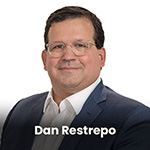To effectively manage migration — go bigger
May 2, 2023
With human mobility at historic levels around the world, including throughout Latin America and the Caribbean, the sense that migration cannot be brought under control is pervasive

When it comes to managing migration in the Americas, it is time to follow President Dwight D. Eisenhower’s advice of how to tackle a problem seemingly too hard to solve — make it bigger.
With human mobility at historic levels around the world, including throughout Latin America and the Caribbean, the sense that migration cannot be brought under control is pervasive. That sense is fueling increasingly drastic attempts to “solve” migration at the U.S.-Mexico border with quick fixes and policy band-aids.
The impulse to do so is driven by thinking of migration narrowly as a phenomena that can be addressed in one place with one set of tools — at the border with enforcement — as the United States has repeatedly done to little lasting avail during the past three decades.
If instead, we take President Eisenhower’s advice and pull back to see the entirety of the challenge — in this case that individuals and families come to the U.S.-Mexico border for myriad reasons as part of a complex system — solutions begin to come into focus. Solution sets outlined in last year’s Los Angeles Declaration on Migration and Protection championed by the Biden administration and agreed to by 22 countries at June’s Summit of the Americas and in a plan put forward by Senator Bob Menendez last week.
The Los Angeles Declaration and Menendez Plan both embrace the core concept of shared responsibility and recognize that to effectively maximize the benefits and mitigate the risks of migration requires multiple, bold, scaled responses — at the border, in the Americas, and in the United States. There is no one place, nor one policy that will bring about safe, legal, and orderly migration in isolation.
Consider, for example, what it will take to solve the “one door, one place” paradox overwhelming U.S. agencies charged with managing border arrivals. For far too many would be migrants across the Americas, the only avenue into the United States is an asylum claim at the U.S. border. Asylum is a vital protection mechanism that must be protected, but it is not a catch-all. Today, the system has a backlog of nearly 1.6 million cases with denials exceeding 70% of cases.
This hurts bona fide asylum seekers fleeing persecution who must wait years for a ruling. Forcing so many resources into asylum adjudication when most people won’t qualify creates deep operational inefficiencies and perverse incentives — leveraged and advertised by smugglers — for people to make ever more dangerous journeys to reach and cross the U.S.-Mexico border without detection.
The asylum system needs reform, as the Menendez Plan calls for, but it also needs pressure relief. Relief that will only come from expanding flexible, legal pathways for migrants and asylum seekers. Establishing more opportunities for legal migration to the U.S. and to countries throughout the Americas, as called for in the Los Angeles Declaration, through work visas, temporary protection mechanisms, educational exchanges, and family reunification programs, will help displace irregular migration and diminish pressure on the asylum system and the border. Creating multiple “doors” for people to enter — as the Los Angeles Declaration and the Menendez Plan envision — advances the interests of migrants and receiving communities.
Alternative pathways are necessary, but insufficient. Effective migration management also demands fostering stable and resilient communities through investment in economic development, education, and social programs throughout Latin America and the Caribbean. To achieve needed scale, we must expand the circle of those who see migration as part of their jobs within the U.S. government to include, among others, the Department of the Treasury and the Development Finance Corporation. As noted in the Menendez Plan, development financing is a critical source of leverage; innovative mechanisms need to be created to “crowd-in” private investment to activate economic recovery in cities hosting millions of migrants across Latin America and the Caribbean.
At home, the United States must also innovate to better support communities stepping up to host migrants and refugees. The embrace of Ukrainians, Cubans, Haitians, Venezuelans, and Nicaraguans through the Biden administration’s innovative parole programs clearly demonstrates the desire average Americans have to help. Experiences from across Latin America demonstrate that efforts to include migrants by, among other things, quickly authorizing their ability to work, has positive effects for host communities, as well as for the migrants themselves.
To find durable, effective solutions, we must go big and grapple with the true dimensions of the migration challenge and resist the siren song of narrow, simplistic approaches bound to fail. The time has come for the Biden administration — and those in Congress serious about managing migration and not just playing politics — to fully embrace and implement the Los Angeles Declaration and the Menendez Plan as the way forward.
Marshall Fitz is Managing Director for Immigration at Emerson Collective.

Dan Restrepo served as Special Assistant to President Obama for Western Hemisphere Affairs.
Read the full article here.

